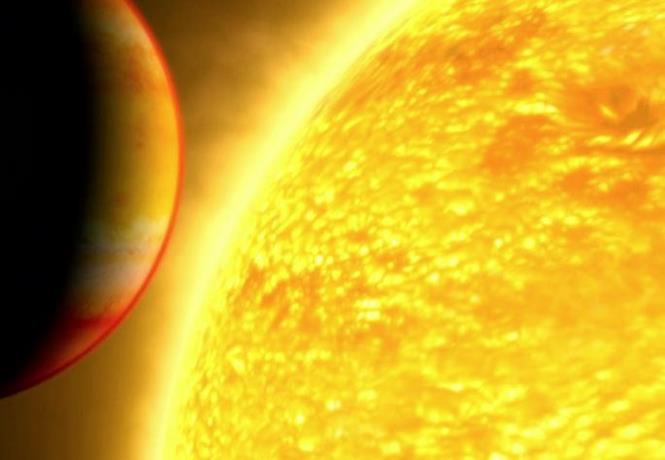A NASA probe rocket will monitor a nearby star to see how starlight affects the atmospheres of exoplanets, key information in the search for life in the universe.
Using an updated instrument first launched in 2019, the mission has a new target: Procyon A, the brightest star in the constellation Canis Minor.
SISTINE-2 (Sub-Orbital Imaging Spectroradiometer for Transition Zone Radiation from Host Stars to Nearby Exoplanets), will get its first launch opportunity from the White Sands rocket cluster in New Mexico on November 8.
Answering the question of whether life exists elsewhere in the universe is fraught with technical challenges. We still can’t travel to planets around other stars, called exoplanets, to see for ourselves. Our telescopes are also not powerful enough to see their surfaces.
Instead, astronomers look at the atmosphere of an exoplanet, searching it for traces of chemicals associated with life. Water, methane, oxygen, ozone and so-called biomarkers produce unique patterns of light that telescopes can detect from afar. But to correctly interpret it, astronomers must look at the planet’s star.
“The interaction between the planet’s atmosphere and the ultraviolet radiation of the host star determines which gases serve as the best biomarkers,” Kevin France, an astrophysicist at the University of Colorado Boulder and principal investigator on the mission, said in a statement.
Some wavelengths of ultraviolet (UV) light, for example, can break down carbon dioxide, releasing one oxygen atom to combine with others to form molecular oxygen (made up of two oxygen atoms) or ozone (made up of three). Stars that shed enough light can create false biomarkers on their planets, sending astronomers looking in the wrong places.
The SISTINE team aims to avoid this dilemma by creating a guide to the wavelengths emitted by each type of star. There are many different types of stars and we don’t yet have a complete picture of their optical output or how it changes over time. Using the starlight catalog, scientists can estimate whether a detected biomarker is a possible sign of life or a false signal caused by disturbing starlight.
On its next flight, it will observe cysteine-2 Procyon A, about 11.5 light-years away. Procyon A is an F-type star, which is slightly larger, hotter, and brighter than our Sun. And while it has no known exoplanets, studying Procyon A can help us understand F-type stars and exoplanets throughout the universe.
“Knowing the ultraviolet spectra of these stars will help us find promising stellar planetary environments with future NASA observatories,” France said.
SISTINE-2 includes a telescope and an instrument known as a spectrometer, which splits light into its separate colors. SISTINE-2 will target ultraviolet light from 100 to 160 nanometers, a range that includes wavelengths known to produce false positive biomarkers. By combining their data with X-rays, extreme ultraviolet radiation, and visible light from other F-type stars, the team hopes to assemble a reference spectrum that will help astronomers interpret biomarkers on exoplanets orbiting F-type stars.
SISTINE-2 also performs hardware testing. Prior to its 2019 flight, the team applied an enhanced lithium fluoride photochromic coating to the device’s mirrors to improve UV reflectance. The results, about three years later, help assess whether this specialized coating might be suitable for larger and longer space missions.
Five minutes into the mission
As on its 2019 flight, the instrument will launch on a Probe rocket, a small suborbital rocket that makes brief observations in space before falling back to Earth. Rising to an estimated altitude of about 280 kilometers to reach ultraviolet light that our atmosphere can absorb, cysteine-2 Procyon A will observe for about five minutes. The tool will then return to the ground, parachute down to heal and recover.
The team is expecting a smooth landing to aid a quick turnaround to be ready for its third launch in July 2022, from the Arnhem Space Center in Nhulunbuy, Australia. There, the revamped SISTINE instrument will observe Alpha Centauri A and B stars, of type G and K, respectively, which are similar and slightly cooler than our Sun, and the stars closest to us.
This system is also home to Proxima Centauri, a cool red dwarf star orbiting the closest known exoplanet, Proxima B. These observations will add additional input to the growing catalog of stars — small but crucial steps in the search for life.

“Proud web fanatic. Subtly charming twitter geek. Reader. Internet trailblazer. Music buff.”




:quality(85)/cloudfront-us-east-1.images.arcpublishing.com/infobae/SXDWOIO7O5FMZOWUATFEXQYWTY.jpg)


More Stories
Astronauts stranded in space due to Boeing spacecraft malfunction won’t be able to return home for weeks
Download YoWhatsApp Plus 2024 Latest Updated APK for Android | WhatsApp Plus APK
What was it like to spend a year on NASA’s Mars simulation base?